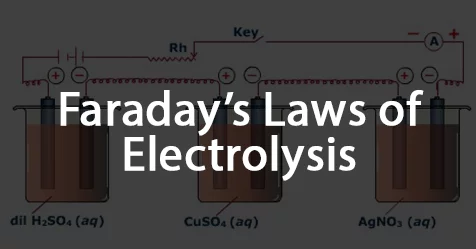Laws of Electrolysis – Introduction
In chemistry, electrolysis can be defined as the process through which an electric current is passed from a substance to bring about a chemical change. This change is a result of the loss or gaining of electrons and requires an electrolytic cell to do so.
In 1833, a scientist named Michael Faraday gave two laws of electrolysis that states how an electric charge would get affected with the material present at the electrode. Along with this, these laws also gave a mathematical expression to justify themselves.
Before knowing about Faraday’s laws of electrolysis, you must understand what an electrode and electrolytic cell are.
What is an Electrode and Electrolytic Cell?
An electrode is a substance that is a good conductor of electricity. Commonly, it is made of gold, carbon, graphite, etc. The main purpose of an electrode is to carry an electric current through the medium it is placed in. The medium can be solid, liquid or gas.
In an electrode, there are two main points known as the cathode and anode. Anode is where the current enters the electrode, whereas the cathode is the point where the current leaves the electrode.
The electrolytic cell converts electric current into chemical energy. It initiates a non-spontaneous chemical reaction to bring about the process of electrolysis.
Now that you know what an electrode and electrolytic cell are, you will be able to understand Faraday’s laws of electrolysis with great ease.
Faraday’s Laws of Electrolysis
In 1833, Michael Faraday did many experiments on electrolysis. He finally established a relationship between the substance present at the electrode and the amount of electrical charge passed through it.
Based on the observations from his experiments, Faraday put down two laws of electrolysis. Faraday’s laws are the most famous ones among all his contributions in chemistry. These laws act as a base for many major researches and chemical procedures that involve electrolysis as the base process.
Faraday’s First Law of Electrolysis
Among the laws of electrolysis, the first law states that the degree of chemical change that occurs in the electrode is directly proportional to the amount of electric charge passed through the electrolyte.
Mathematically, the first law of electrolysis can be stated with the help of the following equation:
m ∝ Q
m = ZQ
m = ZIt
Here,
m = amount or mass of the substance at the electrode, and
Q = quantity of electric charge passed
Z = electrochemical equivalent mass of one-coulomb charge
I = 1 ampere
t = 1 second
Note: The mass of the substance is taken in grams (g), and the quantity of electric charge passed is in coulomb (C).
Faraday’s Second Law of Electrolysis
Among the laws of electrolysis, the second law states that the amount of substance deposited at the electrode when a specific amount of electric charge is passed through it is always directly proportional to the chemical weight of that substance.
This law can also be stated as equal electric charges when passed through different electrolytes will result in the mass of the substance being directly proportional to its chemical equivalent.
Mathematically,
m ∝ E, where
m = amount or mass of the substance at the electrode, and
E = chemical equivalent of the substance
Another way of expressing the second law of electrolysis is
m1/m2 = E1/E2.
The chemical equivalent of any given substance can be calculated as the ratio of its atomic weight and valency. The mathematical representation for this is
E = Atomic Weight/Valency.
Applications of Laws of Electrolysis
Faraday’s laws of electrolysis find multiple uses in the field of chemistry. Researchers use it to carry out major experiments.
Here are some of the most important applications of the laws of electrolysis:
- Metal refining
- Electroplating
- Redox reactions
- Galvanic cells
- Induction motors
Frequently Asked Questions (FAQs)
Q1. What is meant by the chemical equivalent of a substance?
Ans: The chemical equivalent of any substance is the ratio of total atomic mass to its valency. It can be calculated by the formula of Atomic weight/valency of the substance.
Q2. What are the applications of Faraday’s laws of electrolysis in our daily lives?
Ans: Faraday’s laws of electrolysis may not find direct use in our daily lives, but they find several applications in various industrial processes such as electroplating and refining of metals. Along with this, there are several other industries where these laws of electrolysis are widely used.
Q3. What is Faraday?
Ans: Faraday is the electric charge per mole, which was named after the great scientist Michael Faraday. The value of Faraday’s constant is 96485 C/mol, and it is denoted by the symbol F.
Q4. Which apparatus is used to carry out electrolysis?
Ans: There are a whole bunch of apparatuses used to carry out the electrolysis process. These apparatuses altogether are known as a voltmeter. The voltameter is capable of measuring the quantity of electricity or the electric charge passed through a substance.
Q5. What are the conditions needed for electrolysis?
Ans: In order to carry out the electrolysis process successfully, there are three necessary things to have. These include a power cell which is generally a cell; an electrolyte is also needed along with electrodes. Without any of these materials, the electrolysis process cannot proceed.
